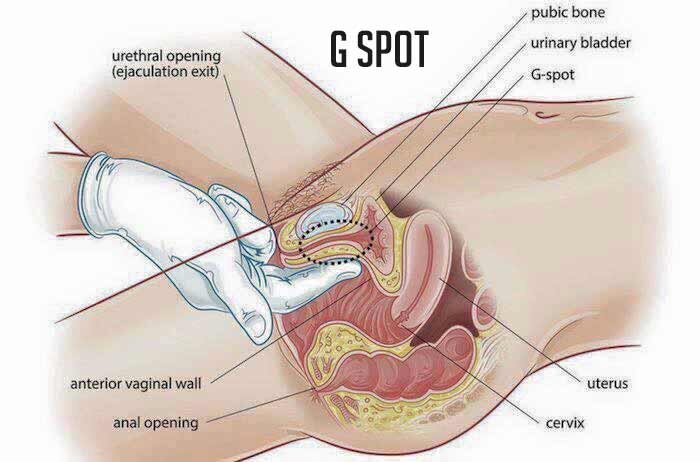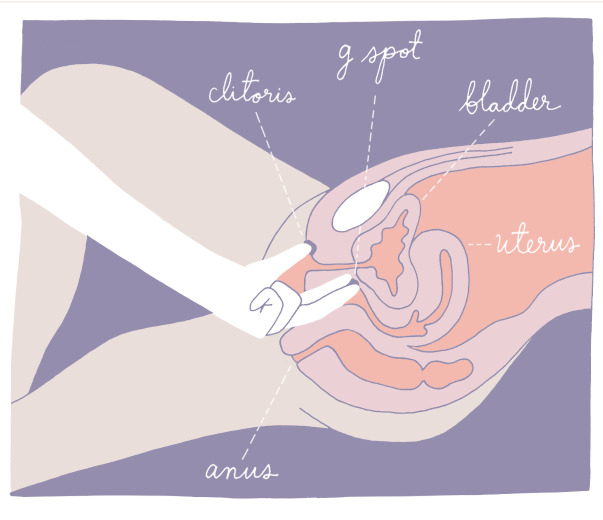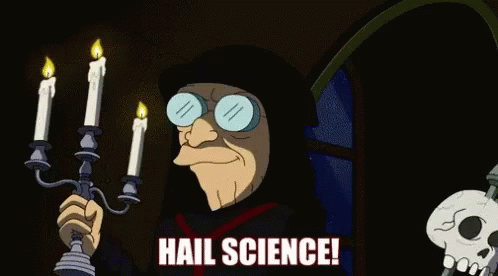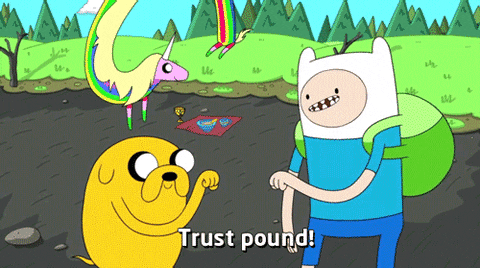The elusive truth about the G-spot
[Estimated reading time: 17 minutes]
People...I love hidden gems. There’s something about the recent trend of hidden, speakeasy style bars that are only accessible if you enter via a cardboard box in an alleyway that appeals to me deeply. I love discovering the secret locations that no one else seems to know about, or reading stories about the hidden worlds hiding in someone’s attic. So today I thought we could talk about the greatest hidden gem of them all - the G-spot!
Why is it called the G-spot?
In case you found yourself wondering, the G stands for Gräfenberg, after Ernst Gräfenberg, a German gynaecologist. Because while there's nothing quite like naming women's anatomy after men, you have to admit the Germans are usually synonymous with fun stuff, like orgasms.
Gräfenberg was quite the prolific achiever, inventing the fore-runner to the modern Copper IUD and writing the paper that laid the groundwork for the discovery of the G-spot, “The role of the urethra in female orgasm.”
In 1950, he stated,
"An erotic zone always could be demonstrated on the anterior wall of the vagina along the course of the urethra."
It’s important to note though, Gräfenberg wasn’t the first to come across the internal pleasure zone - that honour belongs to Regnier de Graaf. Born in 1641, his work preceded Gräfenberg’s by over 200 years. He was the first scientist to identify and describe the ovary. He identified changes in the ovarian structure following fertilization, and witnessed the release of fertilized ova. He is arguably the first to understand the reproductive function of the Fallopian Tube, and even identified a condition within it that could lead to infertility. He managed to do all of this without the use of microscopy, and before his death from plague at the age of 32.
More relevant to our discussions though, he described female ejaculation and in 1642 made a clinical description of the female prostate. Cut to the 1800s and Alexander Skene comes along and is like “Nah, let me plant my flag in this terra nullis - this shall be henceforth known as Skene’s Gland.” Because naming female anatomy after male anatomists purely because they were the only ones allowed to study it is a totally legit method of nomenclature.
Side note, de Graaf was born in a Dutch town called Schoonhoven, and that is now what I’m going to tell everyone the Dutch word for vagina is. Because Gräfenberg shouldn’t have all the fun.
The actual name “G-spot” though didn’t come along until 1981 with the publication of a paper titled “Female ejaculation: A case study” in the Journal of Sex Research. In this paper the researchers referred to the “Grafenberg spot” when describing an ‘erotically sensitive area that could be stimulated through [the] anterior vaginal wall.’
And that, dear readers, is why it’s called the ‘G-spot’ - because Gräfenberg is hard to spell and even harder to use during dirty talk.
What is the G-spot?
There’s a lot of talk about the G-spot, in ‘women’s mags’, jokes in movies, and blurbs on sex toys. But since pleasure is never covered in high school sex education classes, most of us have no way of knowing what it actually is. So let’s take a minute to learn what we’re referring to when we use the term ‘G-spot’.
Imagine your vulva (or someone else’s). Think about the vaginal opening. And now think about where the urethra is in relation to that (tiny little hole, just to the north). Now imagine the urethral and vaginal passages, how they run up inside the body towards the bladder and uterus, respectively.
The G-spot is allegedly a little wad of tissue that sits about 5cm inside the body, comfortably wedged between the urethral and the vaginal passage, just behind the pubic bone. The reason it creates such pleasurable sensations is that it’s made up of tissue from the clitoris, the female prostate gland and the urethra.
Because of where it sits and the various tissues it’s made up of, it’s often easier to find after an extended period of arousal. Porn site Kink.com actually ran a live sex-ed class to provide attendees with a first hand glimpse of the G-spot. They did this by having a performer, Ava, hold a Hitachi wand on her clitoris and inserting a clear speculum into her vagina. After a time, attendees were invited to come up to where Ava was splayed, and look inside to see evidence of the G-spot.
‘“It’s this nice ruffly pink tissue,” [the instructor] said, pointing to the ceiling of Ava’s vagina. “It’s so festive!” Indeed, there was highly visible ruffly pink tissue right where the sometimes-controversial g-spot is said to exist.’
Does the G-spot actually exist?
With evidence like Ava’s on display, and thousands of vagina owners achieving internal orgasms throughout their lives, why are we still talking about whether or not it actually exists? Surely the proof is all there...right?
Well, not exactly. Part of the reason it’s such a fraught issue is that, while many vagina owners report having spectacular orgasms as a result of G-spot stimulation, there are also a significant number of them who remain unable to find this promised land of the vag.
Now a whole lot of scientists and academics heard this and went “This sounds like a job for the scientific method!”
There have been a LOT of studies on the G-spot, trying to determine once and for all whether it exists and the results have been...inconclusive.
In 2012 an academic paper conducted a revision of all the peer-reviewed literature relating to the G-spot, between 1950 and 2011. Their goal was to examine the collected evidence and try to determine once and for all whether it proved the existence of the G-spot, or not. Their findings?
“The literature cites dozens of trials that have attempted to confirm the existence of a G‐spot using surveys, pathologic specimens, various imaging modalities, and biochemical markers. The surveys found that a majority of women believe a G‐spot actually exists, although not all of the women who believed in it were able to locate it.”
However, in their conclusion they also note:
“Objective measures have failed to provide strong and consistent evidence for the existence of an anatomical site that could be related to the famed G‐spot. However, reliable reports and anecdotal testimonials of the existence of a highly sensitive area in the distal anterior vaginal wall raise the question of whether enough investigative modalities have been implemented in the search of the G‐spot.”
The case for denying the existence of the G-spot
It seems like we haven’t been able to prove one way or the other whether it exists, but if so many vagina owners are reporting that they’ve experienced pleasure from this unique location, then what could possibly be the benefit of denying its existence? This isn’t exactly ‘vaccines cause autism’, surely there’s no community harm that could come from just going along with it, right?
Well, there’s a couple of reasons the scientific, academic and sexual health communities are concerned about acknowledging the G-spot without conclusive evidence.
The first problem comes down to the Vagina Burden.
If we make a blanket statement saying that the G-spot exists, the concern is that it will be one more standard that vagina owners are expected to live up to. There’s already unrealistic pressure on vagina owners to behave and perform like porn stars in the bedroom. From squirting and multiple orgasms to being down for anal and deep-throating, vagina owners are often under intense pressure from sexual partners to provide an experience that doesn’t necessarily line up with what they find pleasurable.
If the G-spot receives a blanket acknowledgement, without thorough understanding of where it is, how it works, and who can receive pleasure from it, then we could risk creating yet another unrealistic sexual standard that doesn’t provide pleasure for the person in question.
One of the most famous studies to ‘prove’ the non-existence of the G-spot, was conducted at King’s College London, and involved a 15 year long study of twins. The theory was that if one identical twin self-reported having a G-spot, then it should be more than likely that the other would as well (because they’re biologically identical). But that’s not what happened, so they published their findings as conclusive evidence that the G-spot is a myth. The study co-author though, Andrea Burri, pointed out the importance of announcing their conclusions,
"It is rather irresponsible to claim the existence of an entity that has never been proven and pressurise women and men too." She stated that one of the reasons for the research was to remove feelings of "inadequacy or underachievement" for women who feared they lacked a G-spot.
The second problem is capitalism. Basically, if there’s something that society can make you feel insecure about, then there’s something an unscrupulous organisation can make money from.
Already there are multiple procedures to help ‘enhance’ people’s G-spot experiences. From ‘G-spotplasty’ which involves surgical incisions inside the vaginal anterior wall to the ‘G-shot’ which involves injecting collagen into the vagina to improve sensitivity - G-spot ‘therapies’ are a multimillion dollar business with absolutely zero scientific evidence to support them.
As Devan Stahl from Michigan State University points out,
‘For women who are sexually frustrated, the G-spotplasty reinforces the message that they have a problem, and that the problem is their own body. What is actually statistically normal – difficulty achieving orgasms through penetrative vaginal intercourse – is now considered pathological.’
The case for acknowledging the G-spot
So, with unscrupulous surgeons making millions off vagina owners, and vagina owners being given yet another unrealistic sexual standard to live up to - what possible benefit could there be in acknowledging that the G-spot exists?
Well, remember that study from the 1980s that coined the term ‘G-spot’? One of the authors, Beverly Whipple, remains a passionate advocate for the acknowledgement of the anatomical area. In response to a recent paper attempting to discredit her earlier work, Whipple responded with a very eloquent argument;
‘In our research, we first established that the Gräfenberg spot was a “sexologic” reality, that is, a concept that many women found useful to describe their personal experiences. The second research question concerned the underlying anatomic reality for this experience. Skene's glands, the paraurethral glands, which have often been called the “female prostate” throughout history, emerged as the anatomic basis for the experiences of these women (see Zaviacic, 1999, more than 250 references).
Our purpose in conducting the original research, published in peer-reviewed journals in the early 1980s, was to validate and find a scientific explanation for the reported experiences of many women, not to create new [sexual] goals. These were women who did not fit into the monolithic clitoral-centric model of sexual response, that is, they reported vaginal sensitivity and orgasm from vaginal stimulation and in some cases an expulsion of fluid that was not urine from the urethra [female ejaculation]. By saying that the Gräfenberg spot is a myth, Hines has now contributed to denying women's sexual response and pleasurable experiences.’
Between de Graaf, Grafenburg, Skene, Whipple and multiple studies that have found evidence through ultrasounds, there is more than adequate evidence to make the argument that the G-spot exists in at least some percentage of the vagina owning population. But more importantly there’s the lived experiences of those who have enjoyed pleasure and orgasms from stimulation of that area.
What should have been the significant take away from the twins study by Kings College London, is not that sets of twins report different experiences of the G-spot, but that 56% of them reported having experienced sexual pleasure from this apparently ‘mythical’ area. Basically over half of the people involved in the study self-reported that they enjoyed G-spot stimulation and the conclusion the researchers drew is that ‘yes, but you’re wrong. ’
"The biggest problem with their findings is that twins don't generally have the same sexual partner."
Twins are unlikely to have identical sexual experiences throughout their life. So what’s more likely, that in a set of twins, one managed to have a sexual experience that helped them discover a particular erogenous zone while the other didn’t, or that 56% of women in a study are completely deluded about their experiences of their own body?
The problem with denying the existence of the G-spot is that we contribute further to the erasure of women and vagina owner’s pleasure. Already we fail to educate young people on pleasure as part of sex education, which further contributes to the use of porn as a learning tool. By taking away this terminology, by minimising it, or refusing to acknowledge it we are taking away self-identified pleasure and telling people that their lived experiences of their body is wrong.
Imagine if you mentioned something about your orgasm to a new sexual partner and they raised an eyebrow and said “Oh...you believe orgasms are a thing? You know that’s been debunked right?.”
That’s the attitude we need to reject. Not the terminology of the ‘G-spot’.
What should I think about the G-spot?
We need to let each person’s experience with their own body speak for themselves.
The G-spot shouldn’t be an expectation, no one should demand that anyone be able to experience pleasure or orgasm in a particular way - or at all!
No one should put pressure on themselves to be able to experience pleasure or orgasm in a particular way, or at all.
But for the people who do experience pleasure from stimulating that area, they deserve the language to be able to communicate that - to themselves, to their partners, in their search for toys to stimulate the area, in the language they use to describe their body and its responses.
For the people who have tried unsuccessfully to find their G-spot, or have only experienced discomfort from the process, they are NOT inadequate or broken or dysfunctional. They are not lacking anything.
The G-spot is like the ability to enjoy coriander. Some people think it’s delightful, others think it tastes like soap. Neither person is wrong, because each person is right about their own experience.
How do I find my G-spot (if I have one)?
Now that we understand the complexity surrounding its existence we can start to hunt for our hidden treasure.
We’ve talked a lot about ‘urethral passages’ and ‘anterior vaginal walls’ and whatnot, which is all good and well if we’re being academic, but might be less helpful if you’re trying to finger-bang your way into a new orgasm method.
The way I’ve always described my G-spot to partners is thus:
Find my clitoris
Now imagine where the back side of my clitoris would be, inside my vagina
When you put a finger(s) inside me, make a ‘come hither’ motion on that spot
Once they’re knuckles deep in my Schoonhoven, I usually direct them up, down, or around until they hit the right spot. This can be harder though if you’re trying to find it yourself. I strongly recommend enlisting the use of sex toys to help with G-spot spelunking in your rose-wet cave.
How do I find my G-spot with sex toys?
Remember Kink.com’s friend Ava - remember how she used a Hitachi wand on herself for a bit before her festive pink ruffles were visible?
Well that’s the trick with the G-spot. A lot of the time if you’re just trying to go straight for it, it’s not going to front. It responds to arousal because it contains tissue from areas that also respond to arousal. Sometimes it can be easier to find after you’ve already climaxed once, so don’t be afraid to rub one out before going on the hunt.
If you can use your hands to stimulate your clitoris, that’s great. But there’s no shame in needing some battery operated assistance. Clitoral vibrators are a wonder of the modern age and will not only help lubricate you for the discovery phase, but will make your G-spot easier to find.
Once you’re wet and ready, either you or a partner can fish around for it digitally (e.g. using your digits) or you can try using a correctly shaped dildo to find it. Remember that “come hither” motion we discussed? If we’re translating that shape into a toy, it’s easiest to look for something with a strong curve to it. This is why I’m such a fan of the Njoy wands. The curved design means that once inserted, it’s already heading straight towards the right location.
If you can't find it, or if it's not really feeling as amazing as you'd anticipated, that's okay. Try to focus on pleasure, not outcomes. If you’re concentrating exclusively on finding something that may or may not be there, it’s going to be very hard for you to also be relaxed and aroused. As much as possible, continue bringing your mind back to the sensations you’re experiencing and what feels good. This will help to keep your G-spot all ‘fluffed up’ and ready for you to find, and if it’s not there it means you can still enjoy yourself without feeling like you ‘failed’ at something.
What if my G-spot just makes me need to pee?
If there’s one word that has appeared all too frequently in the life of the G-spot, it’s ‘urethral’. It’s right near your urethral passage, it contains urethral tissue, etc. It’s also important to remember that most of the people involved in its discovery were talking about ‘female ejaculation’.
All of this is to say, when you start playing seriously with your G-spot, there is a strong chance you’ll feel like you need to pee, and there is also a chance that a little bit of pee and/or ejaculate will come out.
This is absolutely nothing to feel ashamed or afraid of. If you’re worried about splooshing a little too hard, just pop down a towel (or a Liberator Throw if it’s a recurring issue) to help with the cleanup.
While stimulating your G-spot, you might feel pressure in your bladder. As much as possible, try and relax. Tell yourself “If I pee, I pee, who cares? It’s sterile and I’m having a good time.” You’ll probably find, once you relax, you don’t actually pee at all. Sort of like those times when your butt is like “We urgently need to poop!” and then you get to the toilet and it sort of just goes “Oh, nah, false alarm.” Just me? Really?
Often the discovery of your G-spot will coincide with the discovery of your ability to ejaculate and/or squirt. Again, neither of these are things to be afraid or ashamed of. If you’re looking for your G-spot with a partner, talk to them about how you would like to handle things if you do end up squirting. Make sure you feel comfortable with them and communicate what you need in order to feel safe.
If you’re looking for your G-spot on your own and you do discover that it causes you to squirt or ejaculate, remember it’s not something you have to do with, or in front of, a partner unless you’re totally comfortable with that happening.
And if you find that stimulating your G-spot only makes you want to pee, but doesn’t actually bring you to climax, that’s okay. It can help in those situations to maintain stimulation on your clitoris while you’re stimulating the G-spot. And if that’s not working, and if using a curved toy hasn’t helped, it’s okay - maybe take a break for a while. I took a 6 month break between finding my G-spot and being able to orgasm from it. These things take time.
Don’t forget there are many different ways to orgasm, and all of them are perfectly valid (including not orgasming at all). There’s nothing wrong with you if your g=spot never ends up doing it for you. It’s coriander, not all of us were made to love it.
That is all.
You may go now.





























